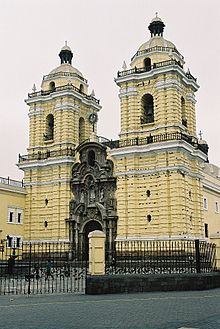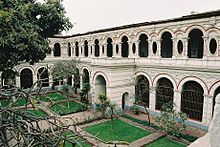- Monastery of San Francisco, Lima
-
Convento de San Francisco is the Spanish name for Saint Francis Monastery located in Lima, Peru at Ancash, south of Parque la Muralla and one block northeast from the Plaza Mayor. The church and convent are part of the Historic Centre of Lima, which was added to the UNESCO World Heritage List in 1991. Aside from a church and monastery it also contains a library and catacombs. In this church, Jude the Apostle is venerated. At the feast of Saint Jude Tadeus a one and a half ton weighing silver stand is carried round in procession by 40 people, starting from the convent.
Contents
Architecture
The church and monastery were consecrated in 1673 and completed in 1774. Though it survived several earthquakes intact in 1687 and 1746, it suffered extensive damage in an earthquake in 1970. The church is noted for its architecture, a high example of Spanish Baroque. Its granite carved portal would later influence those on other churches, including the Church of Merced. The vaults of the central and two side naves are painted in mujedar style: a mix of Moorish and Spanish designs. The head altar is fully carved out of wood. The corridors of the main cloister are inlaid with Sevillian glazed tiles dating from the 1620s. The complex is made of the temple, the convent and two other churches, 'La Soledad' and 'El Milagro'.
Convent
The convent's library is world-renowned. It possesses about 25,000 antique texts, some of them predating the conquest. Some notable books are the first Spanish dictionary published by the Real Spanish Academia and a Holy Bible edition from 1571- 1572 printed in Antwerp.
The staircase towards the library has a spectacular, geometric Moorish-style cuppola in Nicaraguan ceder for a ceiling. It was carved in 1625 and restored in 1969. The choir is positioned on the second floor looking out onto the nave and is made of cedar carved with biblical figures.
Other notable possessions are 13 paintings of the biblical patriarch Jacob and his 12 sons in the refectory, by the hand of the studio of the Spanish master Francisco de Zurbarán. The last supper mural by Peruvian Marcos Zapata depicts typical Peruvian ingredients and meals, instead of European dishes it depicts, such as guinea pig, potatoes and chillis. Also peculiar is the Devil hovering besides Judas. The monastery also possesses several paintings attributed to the school of Pieter Paul Rubens
Catacombs
Lima's first cemetery were the Catacombs below the monastery contain an ossuary and some secrete passageways are said to connect to the cathedral and the Tribunal of the Inquisition. The catacombs remained in use until 1808 when a city cemetery outside of Lima was started. The catacombs were discovered in 1943. It is estimated to contain 70,000 burials. Bones line up along narrow hallways underneath the church, and one area contains several large and deep holes, filled with bones and skulls arranged above each other in circular patterns.
Bibliography
- GUIDE TO PERU, Handbook for travelers, 6th. Edition, by Gonzalo de Reparaz Ruiz, Ediciones de Arte Rep, Lima - Perú, Book edited in English language by the Fondo de Promoción Turística del Perú - FOPTUR.
- Peru, Lonely Planet, edition 2010
- - San Francisco Monastery and Church, Planetware
- Iglesia de San Francisco, Lima , Sacred Destinations
- The Franciscan Monastery official site in English
See also
Coordinates: 12°02′43.79″S 77°01′38.62″W / 12.0454972°S 77.0273944°W
Categories:- Buildings and structures in Lima
- Visitor attractions in Lima
- Colonial Peru
- Christian monasteries in Peru
- Basilica churches in South America
- Roman Catholic churches in Lima
- Religious buildings completed in 1774
- 18th-century Roman Catholic church buildings
- Ossuaries
- Franciscan monasteries in Peru
- Spanish Colonial architecture in Peru
- Neoclassical architecture in Peru
Wikimedia Foundation. 2010.



